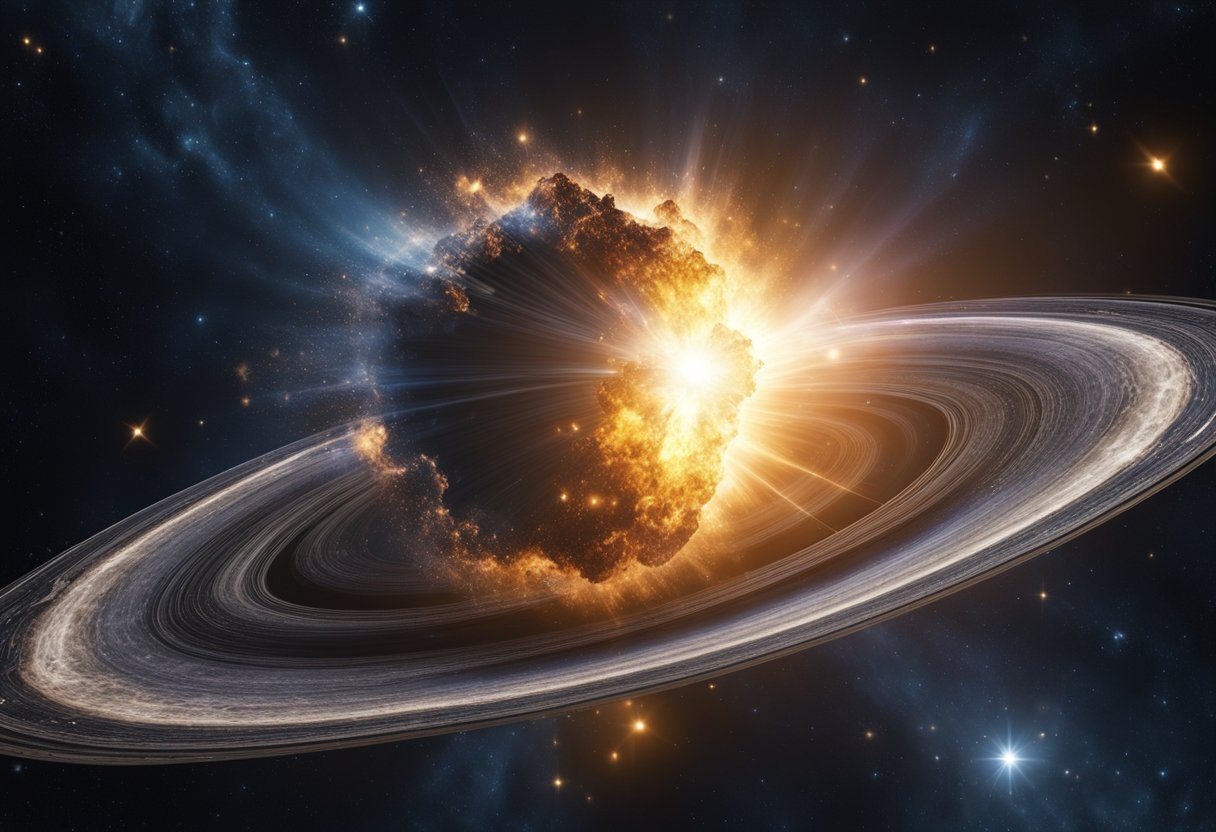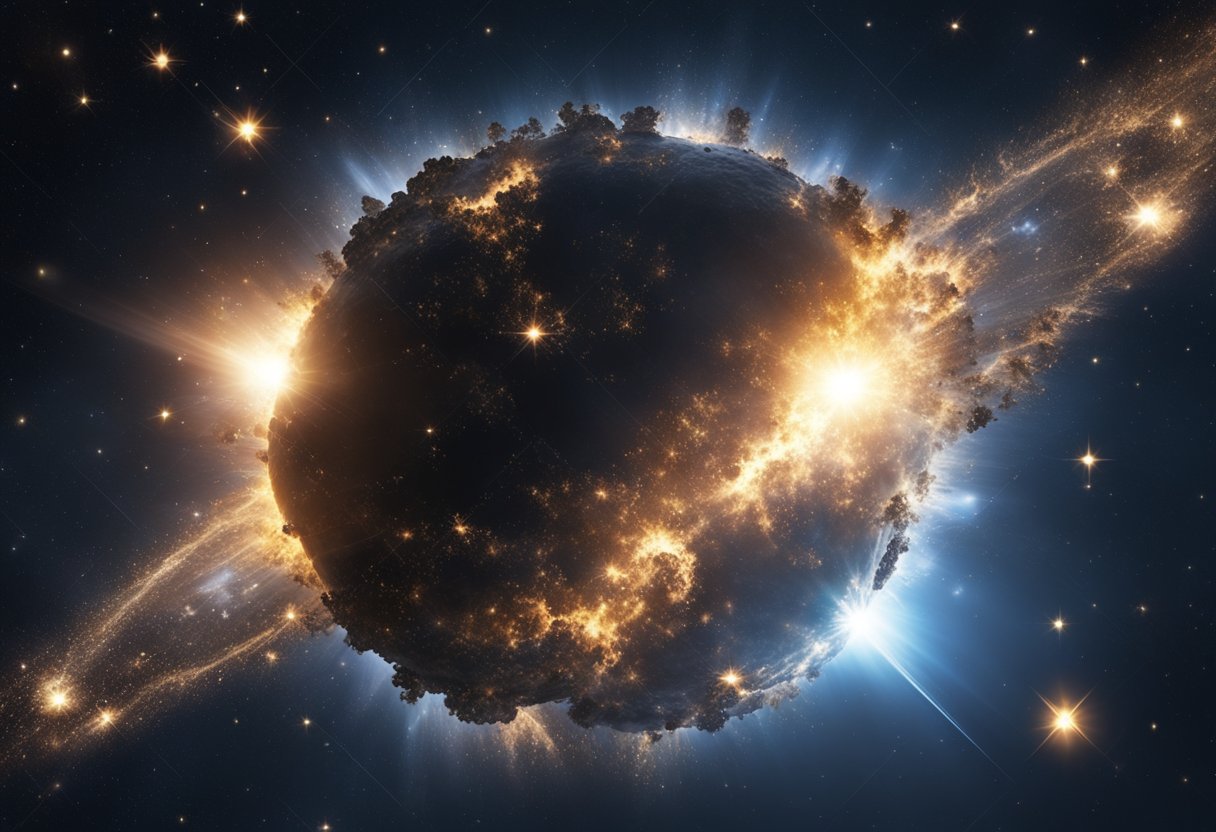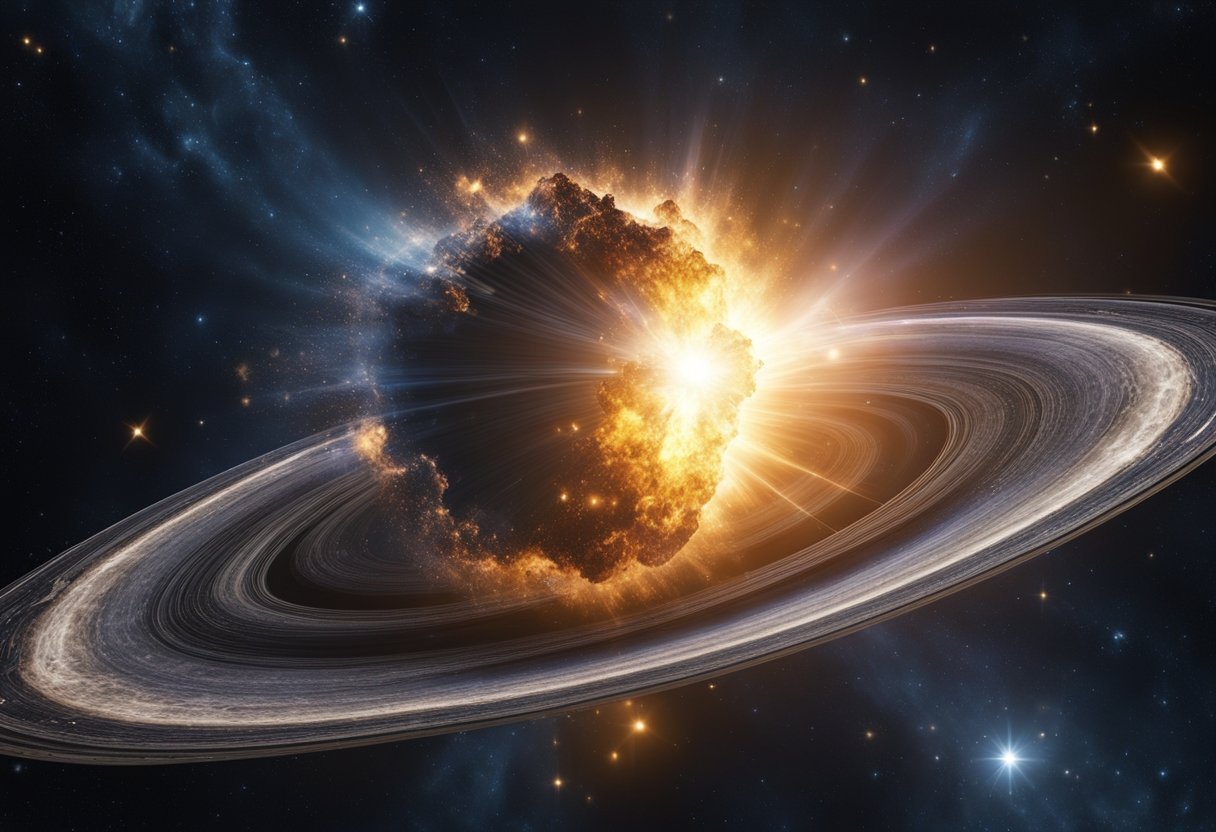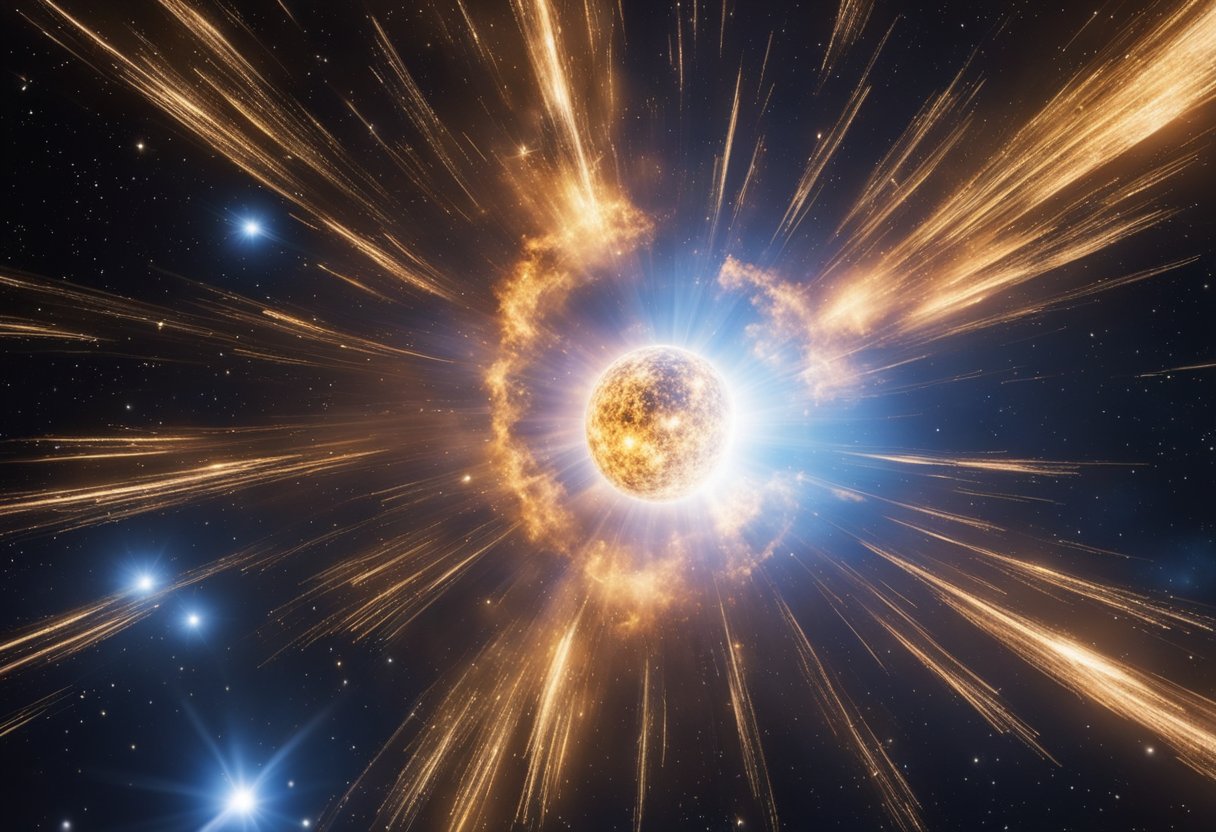
A supernova represents one of the most spectacular events in the universe, marking the explosive death of a star. It occurs when there is a significant change in the core, or centre, of a star. Supernovae can briefly outshine entire galaxies and radiate more energy than our sun will in its entire lifetime. They are also key sources of heavy elements in the universe. Understanding these celestial events is crucial because the elements produced in supernovae are the building blocks of stars, planets, and ultimately life itself.

The occurrence of a supernova is a rare and awe-inspiring event that has been observed throughout history. The combination of intense radiation and the release of a shock wave can trigger the formation of new stars, effectively recycling galactic material. Our curiosity and pursuit of knowledge about these immense cosmic explosions have expanded with advancements in astronomical technology. Telescopes and detectors, now capable of observing these events across various wavelengths, have exponentially increased our capabilities to study these phenomena, granting us insights into stellar life cycles and the evolution of the universe.
We have accumulated extensive records of supernovae over the centuries, with observations dating back to ancient times. These events have not only fascinated observers but have also been key to our understanding of stellar evolution.
Historical records show that Chinese astronomers were meticulous in documenting celestial events. Among these records, one of the earliest noted supernovae is SN 185, referred to as a “guest star” that appeared in 185 AD. It was prominently visible in the night sky for about eight months, providing a prolonged period for ancient astronomers to track its presence. Similarly, SN 1006 is another significant event that stands out as the brightest stellar event recorded by humans. It was widely observed across the world from various cultures.
Further advancing our historical knowledge, the supernova of SN 1054, which led to the formation of the Crab Nebula, was noted by Chinese and Arabic astronomers. These early observations heralded the importance of tracking stellar events in understanding the cosmic phenomena governing our galaxy.
Over time, some supernovae have gained particular prominence due to their impact on astronomical study and methodology. For instance, SN 1572, observed in the constellation of Cassiopeia, marked a significant turning point. Tycho Brahe‘s meticulous observations of this stellar explosion challenged the prevailing notion of the immutability of the heavens and led to the realisation that the universe was more dynamic than previously thought.
In a similar vein, SN 1604, also known as ‘Kepler’s Star’, was the last supernova observed in our own galaxy. Johannes Kepler, a renowned astronomer, conducted detailed studies that contributed greatly to the field. His work, alongside Tycho Brahe’s, laid the foundations for modern astrophysics. While no supernovae have been observed in our galaxy since, the Mount Wilson Observatory continues to contribute to supernova research by studying events in distant galaxies, enhancing our grasp of these colossal explosions.
In discussing the fundamentals of supernovae, we explore the final, explosive events in the lives of certain stars. This section unfolds the nature of supernova events, illuminating their types and the stellar life cycles that lead to such dramatic endings.
Supernovae manifest primarily as two types—Type I and Type II. Significantly, Type I supernovae involve a white dwarf in a binary system. This white dwarf accrues matter from its companion star until it reaches a critical mass and triggers a runaway nuclear fusion. Contrastingly, Type II supernovae are a product of a single massive star undergoing core collapse. This collapse occurs after a star has exhausted its nuclear fuel and the outward pressure can no longer support the star against gravity.
Type II supernovae differentiate themselves by retaining their hydrogen envelopes. They are characterised by a progenitor star that has spent its life as a red giant, eventually leading to neutron stars or black holes if the collapsing core’s mass exceeds the neutron degeneracy pressure.
The path leading to a supernova is an elaborate journey dictated by the mass of the progenitor star. We encounter several stages, with smaller stars transforming into red giants and then cooling to form white dwarfs.
Our understanding of these celestial phenomena is not merely academic—insights into the life and death of stars shed light not only on the vast cosmos but on the potential for future space tourism experiences, akin to those envisioned by ventures like SpaceVoyageVentures.com. These events, both catastrophic and beautiful, not only mark the ends of stellar lives but also kindle the creation of new elements and the birth of future stars.
When a massive star exhausts its nuclear fuel, it can undergo a catastrophic collapse leading to a supernova explosion. These powerful events contribute to the cosmos’s evolution, giving birth to neutron stars and black holes, and scattering heavy elements across the galaxy.
Core-collapse supernovae are the violent end of life for massive stars with an initial mass more than roughly eight times that of our Sun. As these stars exhaust their nuclear fuel, they form an iron core. Once the core reaches the Chandrasekhar limit—about 1.4 times the mass of our Sun—it can no longer support itself against gravitational collapse. The core’s sudden implosion results in a shock wave that blasts the star’s outer layers into space. These catastrophic explosions can leave behind a dense neutron star or, if the core is sufficiently massive, a black hole. Research detailed in Nature emphasises that these supernovae are key to understanding the lifecycles of heavy elements in our universe.
Thermonuclear supernovae, also known as Type I supernovae, principally involve white dwarf stars in binary systems. A white dwarf accumulates material from its companion star and, when its mass approaches the Chandrasekhar limit, the increase in pressure and temperature ignites a runaway nuclear fusion reaction. This reaction doesn’t lead to a collapse but rather to an explosion that completely disrupts the white dwarf. A notable subtype is the Ia category, which is characterised by a particularly uniform luminosity that makes these supernovae useful as standard candles for measuring cosmic distances. While the exact nature of the explosion mechanism in Type I supernovae still holds some uncertainties, they are an integral part of our study of cosmic expansion and astrophysics as outlined by Britannica.
Supernovae are amongst the most luminous events in the cosmos, radiating energy that rivals the output of entire galaxies. Understanding their physical properties, such as luminosity and temperature, is essential for us to comprehend these astronomical phenomena.
A supernova can briefly outshine its host galaxy, emitting as much light as billions of stars combined. This extraordinary brightness results from the rapid conversion of gravitational energy into radiation as the star’s core collapses. To quantify this, we often use the term luminosity, which is the total amount of energy emitted by a supernova per unit of time. For instance, at the peak of its brightness, a typical Type Ia supernova can have a luminosity around ( 10^{9} ) times that of our Sun. In comparison, core-collapse supernovae can be somewhat less luminous, with vast amounts of energy also carried away by neutrinos.
The temperature of a supernova varies throughout its explosion phase, initially reaching upwards of several million Kelvin. As the supernova expands and cools, the spectra it emits evolve significantly. During the early stages, the spectrum is dominated by a continuous emission underlying a series of broad absorption lines, particularly of hydrogen, if the progenitor star had a hydrogen envelope. Gradually, as the expelled material thins and disperses, the spectra become dominated by emission lines. These spectral features, especially the presence of specific hydrogen lines, are pivotal for us to classify supernovae into different categories, such as Type II supernovae, which exhibit these hydrogen signatures, versus Type Ia supernovae, which do not.

In the dramatic life cycle of stars, mass and gravity play critical roles, particularly in the cataclysmic event of a supernova. Our discussion takes us to the brink of stellar collapse and beyond.
The Chandrasekhar Limit is pivotal in understanding why supernovae occur. It represents the maximum mass—approximately 1.4 times that of our Sun—that a white dwarf star can sustain before gravity overwhelms the internal pressure, leading to a potential supernova. When white dwarfs encounter this limit, their core is no longer able to support the star against gravitational collapse, which may set the stage for a Type Ia supernova.
Massive stars, typically more than eight solar masses, face a different destiny. As these stars exhaust their nuclear fuel, the outward pressure generated by fusion declines. Without sufficient pressure to counterbalance it, gravity becomes the dominating force. This tug-of-war eventually culminates in the core’s gravitational collapse, spawning either a neutron star or a black hole and releasing a tremendous amount of energy in a supernova explosion.
Within the cores of stars, remarkable nuclear processes convert hydrogen into progressively heavier elements, releasing energy that sustains the star’s glow. This intricate alchemy is the universe’s way of creating the elements that make up our world.
Fusion is the fundamental reaction that powers the stars, converting hydrogen into helium under extreme temperatures and pressures at the star’s core. This process releases vast amounts of energy, which we observe as starlight. In the cores of stars much like our Sun, this hydrogen-to-helium fusion is facilitated through the proton-proton chain reaction, where pairs of protons fuse to eventually form helium-4.
As stars age and their hydrogen supply diminishes, they begin fusing helium into carbon and oxygen. This fusion occurs in sequential processes known as carbon burning and oxygen burning. Advanced stages of fusion lead to the creation of even heavier elements up to iron, which is the end product of fusion in a star’s lifecycle. Beyond iron, further nucleosynthesis occurs during the explosive force of a supernova, where rapid neutron capture events create an array of heavy elements beyond iron.
In our pursuit to understand cosmic phenomena such as supernovae, we have developed sophisticated observational tools and methods. These allow us to detect these explosive events and analyse their properties in great detail.
We utilise telescopes as our primary tools for observing supernovae. Ground-based telescopes have been instrumental in these discoveries, but the advent of space telescopes, like the Hubble Space Telescope, has dramatically increased our capabilities. The Hubble, operated by NASA and ESA, allows us to view cosmic events unobstructed by Earth’s atmosphere, resulting in clearer and more detailed images. It uses a suite of instruments to detect different types of energy, including visible light, ultraviolet, and near-infrared.
When it comes to understanding the nature of supernovae, spectral analysis is key. We analyse the spectra of these events to determine their composition, temperature, density, and velocity.
By examining the light across different wavelengths, we can also determine the distance to a supernova, which aids in our understanding of the size and expansion rate of the universe. Our ongoing observational efforts are supported by collaborations between international space agencies like NASA and ESA, ensuring that we continually refine our methods and expand our knowledge of the cosmos.
Supernovae are cataclysmic events that have profound effects on the cosmos, shaping the structure of galaxies and contributing to the chemical richness of the universe.
We observe that when a star explodes as a supernova within a galaxy, the resulting shockwaves can trigger the formation of new stars in the surrounding interstellar medium. This process can also lead to enormous clouds of gas and dust, known as a nebula, which can be observed in various galaxies, including our own Milky Way and the nearby Large Magellanic Cloud. The energy released by supernovae contributes to the dynamic nature of the galaxy’s structure, stirring the interstellar medium and influencing the evolutionary path of the galaxy.
Supernovae play a critical role in enriching the universe with heavy elements. These stellar explosions are responsible for dispersing elements like carbon, oxygen, and iron into the cosmos, which are essential for the formation of planets and life as we understand it. Through this process, known as nucleosynthesis, supernovae contribute significantly to the chemical evolution of galaxies, seeding the interstellar medium with the building blocks for future star systems. As successive generations of stars are born and die, they further process and distribute these heavy elements throughout the universe.
In this section, we explore the enduring legacies of supernovae: the fascinating Crab Nebula and the birth of exotic objects like neutron stars and black holes.
The Crab Nebula, a well-studied supernova remnant, is the aftermath of a stellar explosion that was recorded in 1054 CE. It is now known for its association with a pulsar, a highly magnetised, rotating neutron star that emits a beam of electromagnetic radiation observable as pulses when it is aligned with our line of sight. Pulsars like the one at the heart of the Crab Nebula are astronomical beacons, radiating across the spectrum from radio waves to gamma-ray bursts, key to understanding the universe’s extreme physics.
When massive stars collapse under their gravity, they can leave behind dense cores known as neutron stars. If the remaining mass is sufficient, it may further collapse into a black hole, an area in space from which not even light can escape. Researchers have accumulated evidence suggesting that supernovae are indeed the cosmic crucibles where both neutron stars and black holes are forged, contributing not only to our knowledge of stellar evolution but also to the mysterious dark energy that propels our universe’s acceleration.
Supernovae have had profound impacts on Earth, from potential threats to beneficial contributions in the form of galactic elements.
We understand that supernovae can pose serious threats to life on our planet. Though none are imminent, the sheer energy released by a star’s explosion could profoundly alter Earth’s environment if close enough. A supernova within the immediate vicinity of our solar system—approximately 30 light-years away—could strip away the ozone layer, increasing exposure to harmful UV radiation.
On the other hand, supernovae have been integral to dispersing elements necessary for life throughout the universe. These cataclysmic events forge heavy elements like iron and scatter them into space, where they can eventually become part of planets like our own Earth. Some theories suggest that shockwaves from supernovae could even trigger the formation of comets and other small bodies in the solar system.
Our knowledge of these celestial phenomena could be significantly expanded through proposed space tourism ventures, as SpaceVoyageVentures.com is exploring, furthering our understanding of these galactic events.

As we look towards the horizon of cosmic exploration, the study of supernovae promises remarkable advancements. Our understanding of these stellar explosions will expand with new technologies and deeper theoretical insights.
The European Space Agency (ESA) and NASA remain at the forefront of developing sophisticated devices to observe supernovae in distant galaxies. The deployment of powerful space telescopes like the Hubble Space Telescope has been pivotal, but the future beckons even more advanced tools. We’re set to witness a leap in supernova observation capabilities with the introduction of next-generation telescopes. These instruments will boast superior resolution and sensitivity, unlocking the potential to capture previously elusive supernova events. This will not only provide more frequent detections but also a richer understanding of the diverse types of supernovae and the mechanisms underlying their explosions.
Parallel to the technological strides, our theoretical research is deepening. We leverage complex simulations to predict supernova occurrences and their subsequent impact on galactic evolution. Detailed models that we develop inform us about the life cycles of stars and the intricate processes leading to their demise as supernovae. By coupling these simulations with observational data, we refine our predictions and enhance our ability to forecast stellar events, much like how astronomers have posited the reappearances of specific supernovae, such as the Supernova Requiem expected in 2037.
With these upcoming advancements, we pave the way for a new era in astrophysics, keenly anticipating the continued unveiling of the universe’s grandest fireworks, one supernova at a time.
We explore some of the most intriguing aspects of supernovae, the astonishingly luminous explosions of stars.
A star explodes as a supernova towards the end of its life cycle when it has exhausted its nuclear fuel. This depletion leads to an imbalance between the gravitational force and the outward pressure, ultimately causing the star to collapse and explode. This process results in a supernova, which briefly outshines entire galaxies and radiates more energy than our Sun will in its entire lifetime.
A supernova occurs somewhere in the universe approximately every 10 seconds. However, due to the vastness of the universe and the limitation of our observational technology, not all of these are detectable or observed from Earth.
The most recent supernova observed from Earth, SN 1987A, exploded in the Large Magellanic Cloud, a nearby dwarf galaxy, in 1987. It was the closest observed supernova since Kepler’s supernova in 1604 and provided valuable data for astrophysicists.
Among the most notable supernovae recorded in history is Tycho’s supernova (SN 1572), named after the astronomer Tycho Brahe who studied it in detail. Another famous one is SN 1054, which resulted in the Crab Nebula. These events have been critical in our understanding of stellar evolution.
A supernova explosion is characterised by an immense burst of energy, luminosity, and the ejection of material into space. The explosion distributes heavy elements, contributing to the cosmic chemical abundance and playing a role in the formation of new stars and planets. Supernovae also leave behind exotic objects such as neutron stars or black holes.
While there have been no supernovae observed within the Milky Way in modern times, astronomers constantly monitor stars that could potentially become supernovae. The study of remnants and historical records enhance our understanding and assist us in predicting future supernova events.